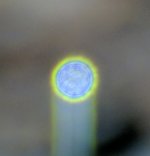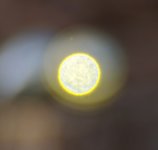I recently purchased an Swarovski ATX95 spotting scope. Since I could not find one around here I did mail order and decided that I would try to verify myself if I thought I got a good example.
Now this is the first time that I have really tried doing this. I did not have a doubler or any magnifier to put on the scope but was really just looking to do confirmation testing and not trying to trouble shoot a questionable result.
My setup was using a small steel bearing set on a post about 35 yards away and shinning a 960 lumen cree led flashlight on it.
I was able to see clear rings on the inside focus and a little on the outside focus. I have attached some photo's that I took using a phone digiscope adapter and about 4x on the digital zoom. The view through the scope was a lot clearer than these pictures show.
Am I correct in saying that these seem to represent a decent sample? I know that perfect optics would have consistent inside and outside views, but that is unusual in a spotting scope correct?
I also have a Zen-Ray prime HD 20-60 spotting scope that I had side by side. The inside focus on that scope looked very much like the pictures that Henry Link posted from the "good" sample that has a impingement at about the 4:00 o'clock position, I could not get any decent pictures from that scope.
When I put them both on a USAF target I was able to resolve two additional elements on the ATX compared to the Zen-Ray both at 60x, when I bumped the ATX to 70x I was able to resolve two more elements.
So do these look like a good sample? It seems so to me and certainly has a much better view that the Zen-Ray.
The one thing that I have not cared for yet on the ATX is the hood which seems quite sticky and hard to move either in or out. I can't really move it with the scope case on. Maybe it frees up over time. As many have stated the zoom adjustment is fairly stiff and has a fair bit of turn, but I expect that.
Also if it looks like I'm doing anything wrong, please let me know. As I said I very new to all of this.
Thanks for your time and comments!
Scott
Now this is the first time that I have really tried doing this. I did not have a doubler or any magnifier to put on the scope but was really just looking to do confirmation testing and not trying to trouble shoot a questionable result.
My setup was using a small steel bearing set on a post about 35 yards away and shinning a 960 lumen cree led flashlight on it.
I was able to see clear rings on the inside focus and a little on the outside focus. I have attached some photo's that I took using a phone digiscope adapter and about 4x on the digital zoom. The view through the scope was a lot clearer than these pictures show.
Am I correct in saying that these seem to represent a decent sample? I know that perfect optics would have consistent inside and outside views, but that is unusual in a spotting scope correct?
I also have a Zen-Ray prime HD 20-60 spotting scope that I had side by side. The inside focus on that scope looked very much like the pictures that Henry Link posted from the "good" sample that has a impingement at about the 4:00 o'clock position, I could not get any decent pictures from that scope.
When I put them both on a USAF target I was able to resolve two additional elements on the ATX compared to the Zen-Ray both at 60x, when I bumped the ATX to 70x I was able to resolve two more elements.
So do these look like a good sample? It seems so to me and certainly has a much better view that the Zen-Ray.
The one thing that I have not cared for yet on the ATX is the hood which seems quite sticky and hard to move either in or out. I can't really move it with the scope case on. Maybe it frees up over time. As many have stated the zoom adjustment is fairly stiff and has a fair bit of turn, but I expect that.
Also if it looks like I'm doing anything wrong, please let me know. As I said I very new to all of this.
Thanks for your time and comments!
Scott






